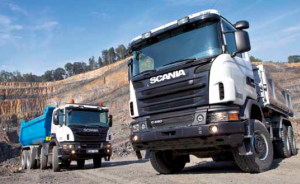By Henrik Fagrenius, Managing Director, Scania Commercial Vehicles India Private Ltd.
 All production systems, when viewed at the most abstract level, might be said to be “transformation processes”, processes that transform resources into useful goods and services. The transformation process typically uses common resources such as labour, capital (for machinery and equipment, materials), and space (land, buildings) to effect a change. Economists call these resources the “factors of production” and usually refer to them as labour, capital and land. Production managers refer to them as the “five Ms” – men, machines, methods, materials and money.
All production systems, when viewed at the most abstract level, might be said to be “transformation processes”, processes that transform resources into useful goods and services. The transformation process typically uses common resources such as labour, capital (for machinery and equipment, materials), and space (land, buildings) to effect a change. Economists call these resources the “factors of production” and usually refer to them as labour, capital and land. Production managers refer to them as the “five Ms” – men, machines, methods, materials and money.
A flexible modern production is to meet individual customer demands while remaining competitive by producing on an industrial scale. Customized production offers prospects for growth and employment. It requires state-of-the-art technologies that promote efficient and flexible quality production while minimizing delivery periods. Making products to customer order is already a common feature in the automobile industry.
Scania’s modular product system which has been built up over several decades makes it possible for the company to create individual specifications for a large number of different customers by using a limited number of components in its product range. This enables each customer to receive an optimised product, while keeping costs throughout the value chain at a more competitive level than otherwise possible.
To a growing extent, Scania uses shared components in trucks, buses and coaches, as well as industrial and marine engines. Some examples: all Scania engines have the same cylinder architecture, and a Scania coach today has a large number of chassis and power train components in common with a truck chassis.
Furthermore, all of Scania’s truck cabs, regardless of size, have the same interface with the chassis. All engines and gearboxes have the same mounting points on the chassis, irrespective of size. The chassis in turn is built up by a large number of frame components that fit together in innumerable combinations.
 The key concepts, then as well as today, are: standardised interfaces, few components and carefully defined steps for each line of components. This yields a specification system with immense variability, few components and as many shared parts as possible.
The key concepts, then as well as today, are: standardised interfaces, few components and carefully defined steps for each line of components. This yields a specification system with immense variability, few components and as many shared parts as possible.
In 1980 when Scania unveiled the 2-series, or GPRT range, it was regarded as a major technical success. For the first time, Scania presented an entire commercial vehicle model range largely based on modules.
The modular philosophy not only means that vehicles can be tailored to the needs of individual customers. It has also been an important factor for product development at Scania. Each individual component, such as the engine, transmission, frame, cab and axles, can be further refined independently of other components. Improvements are introduced continuously as soon as they have been thoroughly tested, always giving customers access to the latest execution.
Scania’s business model must not be confused with standardisation. The objective is to tailor solutions for each one of their customers. Modularisation begins and ends with the customer. Every vehicle delivered is specifically put together with an eye to a unique customer’s driving pattern, industry, legal environment, topography and climate.
By choosing Scania, customers get more than a premium grade vehicle. They also get an array of tailor-made services solutions designed to keep their business moving forward. Scania has a reputation for delivering maximum uptime, making ownership an even more enjoyable and profitable experience. Scania can do everything to put you in the lead and keep you there, by offering outstanding services related to your vehicle as well as business-oriented solutions such as financing and fleet management.
To support its customers in the best possible way, Scania is using its many service concepts to complement the multi-million possibilities built into its modular product system and tailor solutions for traditional as well as new requirements:
Repairs and maintenance are provided through a growing global network of more than 1,600 workshops with 14,000 dedicated service technicians). This ensures that irrespective of where the customer is located in, the same quality standards and professionalism are offered by Scania. Many of Scania workshops offer extended working hours, which helps maximise the uptime.
 Scania parts are designed for high quality, a long service life and a perfect fit minimizing downtime and maximizing value, and every part comes with a borderless warranty. Because Scania has one of the most advanced logistics systems in the world, the workshops can offer high availability of every one of the 65,000 parts in the inventory, not just frequently ordered parts.
Scania parts are designed for high quality, a long service life and a perfect fit minimizing downtime and maximizing value, and every part comes with a borderless warranty. Because Scania has one of the most advanced logistics systems in the world, the workshops can offer high availability of every one of the 65,000 parts in the inventory, not just frequently ordered parts.
Scania fleet management, a set of computer-based services, connects the customer to the fleet via satellite, wherever it may be. An array of applications provides access to information and data that can help cut fuel and other costs, simplify logistics, improve customer service enabling business growth, and improve environmental performance.
Financial and insurance solutions
Scania financial service is dedicated to helping the customers grow and protect their business. Scania’s flexible financial solutions make costs more predictable and risks more manageable throughout the entire life cycle of vehicles. Whether the customer wants to own, lease or simply operate your fleet, Scania can tailor a financial solution that’s right for your business.
Scania offers insurance cover tailored to protect individual vehicles or whole fleets. And with a single telephone number for all contacts, administration is fast and simple, giving you more time to concentrate on your business.
Scania truck can be individually equipped to make life on the road still easier and more enjoyable. Customers can have microwave oven, coffee maker or refrigerator fitted on delivery. And if more personal touch is what a customer needs, the Scania combinations are almost endless.
Scania Driver Training can help even the most experienced drivers to drive more economically and more safely and make a dramatically positive impact on your bottomline. Customers can expect to save about 10 per cent on fuel alone, with a significant reduction in emissions. What’s more, tyres will last longer, and the power train will last longer and consume less oil. And lower costs means higher margins.
A well-trained driver is far less likely to be involved in an accident, meaning less unplanned downtime and lower insurance premiums. And more uptime means more business for you. When you take all these factors into consideration, it’s clear to see how quickly investment in driver training pays for itself usually in just a few months.
To boost your payoff from driver training, Scania has introduced Scania Driver Support, which is now standard on long-haulage trucks. Using sensors in the truck and an innovative instrument panel display it coaches drivers with feedback to help them maintain the good driving skills they learned during driver training.
Major advantages
The Scania Production System offers many advantages to customers. It gives them an exceptionally wide choice that enables vehicles to be tailored to any type of transport, increases access to parts on a global basis, simplifies repairs and servicing, shortens downtime, ensures a high, uniform quality level at workshops, and with product similarity, it secures high competence in the service network.
Modularisation is a viable product strategy for new markets. By continuing to refine its modular product system, Scania is able to reach out to newer customers and offer them cost-effective solutions, thereby laying the groundwork for profitable growth for these customers too.
By choosing Scania, the customer gets an array of tailor-made services solutions designed to keep the business moving forward. Scania has a solid reputation for delivering maximum uptime, making ownership an even more enjoyable and profitable experience.